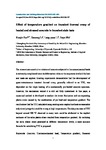Effect of temperature gradient on transient thermal creep of heated and stressed concrete in transient state tests
| dc.contributor.author | Fan, K | |
| dc.contributor.author | Li, D | |
| dc.contributor.author | Li, Long-yuan | |
| dc.contributor.author | Wu, J | |
| dc.date.accessioned | 2019-07-05T17:45:38Z | |
| dc.date.available | 2019-07-05T17:45:38Z | |
| dc.date.issued | 2019-10-20 | |
| dc.identifier.issn | 0950-0618 | |
| dc.identifier.issn | 1879-0526 | |
| dc.identifier.uri | http://hdl.handle.net/10026.1/14605 | |
| dc.description.abstract |
The stress-strain constitutive relation of concrete subjected to thermomechanical loads is extremely complicated since its deformation relies on the sequences in which the heat and loads are applied. Existing experiments demonstrated that the development of quasi-instantaneous transient thermal creep, generally referred to as TTC, was dependent on the virgin heating of a mechanically pre-loaded concrete specimen. However, the mechanism behind it is still not fully understood. In this paper, a numerical method is developed to analyze the stress fluctuation and corresponding plastic strain caused by the combination of pre-load and temperature gradient. The results show that the TTC calculated using existing semi-implicit methods is reasonable only at early stage but could be wrong at high temperatures. The sharp increase of TTC beyond around 500 °C observed in many tests could be attributed to the implicit inclusion of the extra plastic strain resulted from temperature gradient. By excluding the extra plastic strain generated at different temperature levels, a more accurate formula for calculating TTC is proposed. | |
| dc.format.extent | 839-851 | |
| dc.language | en | |
| dc.language.iso | en | |
| dc.publisher | Elsevier | |
| dc.subject | Concrete | |
| dc.subject | Thermo mechanical load | |
| dc.subject | Temperature gradient | |
| dc.subject | Transient thermal creep | |
| dc.subject | Load induced thermal strain | |
| dc.subject | Explicit model | |
| dc.title | Effect of temperature gradient on transient thermal creep of heated and stressed concrete in transient state tests | |
| dc.type | journal-article | |
| dc.type | Journal Article | |
| plymouth.author-url | https://www.webofscience.com/api/gateway?GWVersion=2&SrcApp=PARTNER_APP&SrcAuth=LinksAMR&KeyUT=WOS:000483454300074&DestLinkType=FullRecord&DestApp=ALL_WOS&UsrCustomerID=11bb513d99f797142bcfeffcc58ea008 | |
| plymouth.volume | 222 | |
| plymouth.publication-status | Published | |
| plymouth.journal | Construction and Building Materials | |
| dc.identifier.doi | 10.1016/j.conbuildmat.2019.06.197 | |
| plymouth.organisational-group | /Plymouth | |
| plymouth.organisational-group | /Plymouth/Faculty of Science and Engineering | |
| plymouth.organisational-group | /Plymouth/Faculty of Science and Engineering/School of Engineering, Computing and Mathematics | |
| plymouth.organisational-group | /Plymouth/REF 2021 Researchers by UoA | |
| plymouth.organisational-group | /Plymouth/REF 2021 Researchers by UoA/UoA12 Engineering | |
| plymouth.organisational-group | /Plymouth/Research Groups | |
| plymouth.organisational-group | /Plymouth/Research Groups/Marine Institute | |
| plymouth.organisational-group | /Plymouth/Users by role | |
| plymouth.organisational-group | /Plymouth/Users by role/Academics | |
| dcterms.dateAccepted | 2019-06-24 | |
| dc.rights.embargodate | 2020-7-2 | |
| dc.identifier.eissn | 1879-0526 | |
| dc.rights.embargoperiod | Not known | |
| rioxxterms.funder | European Commission | |
| rioxxterms.identifier.project | Partnership for Research in Geopolymer Concretes | |
| rioxxterms.versionofrecord | 10.1016/j.conbuildmat.2019.06.197 | |
| rioxxterms.licenseref.uri | http://www.rioxx.net/licenses/all-rights-reserved | |
| rioxxterms.licenseref.startdate | 2019-10-20 | |
| rioxxterms.type | Journal Article/Review | |
| plymouth.funder | Partnership for Research in Geopolymer Concretes::European Commission |


